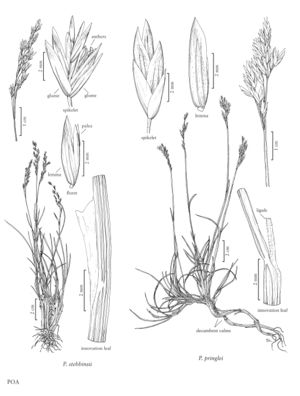Poa pringlei
Plants perennial; densely tufted, not stoloniferous, not rhizomatous. Basal branching intravaginal. Culms 5-35 cm tall, 0.5-0.9 mm thick, erect or the bases decumbent, with 0 (1) exserted nodes. Sheaths closed for 1/7 - 1/3 their length, terete, smooth or sparsely scabrous, glabrous, bases of basal sheaths glabrous, distal sheath lengths 2-4 times blade lengths; collar margins smooth or scabrous to hispidulous; ligules of cauline leaves 1-6 mm, colorless, translucent, smooth or scabrous, truncate to acute, ligules of the innovations 1-2.5 mm; innovation blades similar to the cauline blades, 1.5-3 mm wide, involute, thick, frequently somewhat arcuate, abaxial surfaces smooth, adaxial surfaces densely scabrous or hispidulous; cauline blades becoming only slightly shorter distally, 1.5-3 mm wide, involute, moderately thick, soft to moderately firm, abaxial surfaces smooth, apices narrowly prow-shaped. Panicles 1-6 cm, erect, narrowly lanceoloid to ovoid, moderately congested, with 6-20 (25) spikelets; nodes with 1-2 branches; branches 0.5-1.5 (2) cm, erect, moderately stout, terete or weakly angled, angles smooth to fairly densely scabrous, with 1-3 spikelets. Spikelets 6-8 (12) mm, lengths to 3.5 times widths, broadly lanceolate, laterally compressed, not sexually dimorphic, lustrous; florets 2-5; rachilla internodes smooth. Glumes subequal, isomorphic, lanceolate to broadly lanceolate, thin, lustrous, distinctly keeled, keels smooth or sparsely scabrous; lower glumes shorter than the adjacent lemmas, 3-veined; calluses glabrous; lemmas 5-8 mm, lanceolate, distinctly keeled, thinly membranous, smooth or sparsely finely scabrous, glabrous, lateral-veins moderately prominent, margins glabrous, apices acute; palea keels coarsely scabrous; anthers vestigial (0.1-0.2 mm) or 2-4 mm. 2n = unknown.
Distribution
Calif., Oreg., Nev.
Discussion
Poa pringlei grows on rocky subalpine and alpine slopes in Oregon and California. Sexual populations, with approximately equal numbers of pistillate and staminate plants, are confined to the Klamath-Siskiyou region; Sierra Nevada populations are pistillate and apomictic. Hitchock (1951) included P. cusickii subsp. pallida (p. 560), P. keckii (p. 584), and P. suksdorfii (p. 584) in P. pringlei; the illustration (Fig. 171) is of P. cuscikii subsp. pallida.
Hybrids otPoa pringlei with P. cusickii (p. 560) have been found on Mount Shasta, California, Mount Rose, Nevada, and near Crater Lake, Oregon. Poa pringlei differs from P. curtifolia (p. 589) in being dioecious and in having blades that are involute, soft to moderately firm, and abaxially pubescent.
Selected References
None.
Lower Taxa
"thin" is not a number.No values specified."decumbent" is not a number."thick" is not a number.
